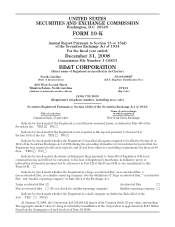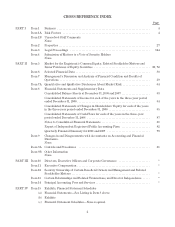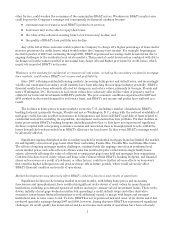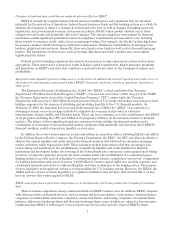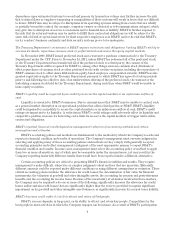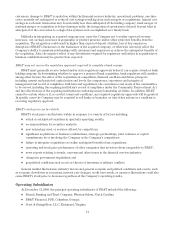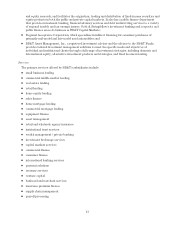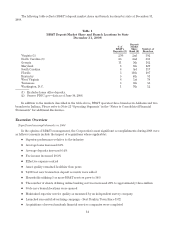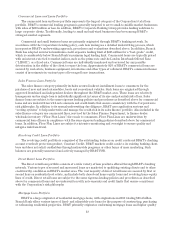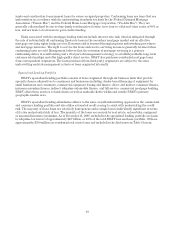BB&T 2008 Annual Report Download - page 9
Download and view the complete annual report
Please find page 9 of the 2008 BB&T annual report below. You can navigate through the pages in the report by either clicking on the pages listed below, or by using the keyword search tool below to find specific information within the annual report.dependence upon automated systems to record and process its transaction volume may further increase the risk
that technical flaws or employee tampering or manipulation of those systems will result in losses that are difficult
to detect. BB&T also may be subject to disruptions of its operating systems arising from events that are wholly
or partially beyond its control (for example, computer viruses or electrical or telecommunications outages), which
may give rise to disruption of service to customers and to financial loss or liability. BB&T is further exposed to
the risk that its external vendors may be unable to fulfill their contractual obligations (or will be subject to the
same risk of fraud or operational errors by their respective employees as is BB&T) and to the risk that BB&T’s
(or its vendors’) business continuity and data security systems prove to be inadequate.
The Treasury Department’s investment in BB&T imposes restrictions and obligations limiting BB&T’s ability to
increase dividends, repurchase common stock or preferred stock and access the equity capital markets.
In November 2008, BB&T issued preferred stock and a warrant to purchase common stock to the Treasury
Department under the CPP. Prior to November 14, 2011, unless BB&T has redeemed all of the preferred stock,
or the Treasury Department has transferred all of the preferred stock to a third party, the consent of the
Treasury Department will be required for BB&T to, among other things, increase common stock dividends or
effect repurchases of common stock or other preferred stock (with certain exceptions, including the repurchase of
BB&T common stock to offset share dilution from equity-based employee compensation awards). BB&T has also
granted registration rights to the Treasury Department pursuant to which BB&T has agreed to lock-up periods
prior to and following the effective date of an underwritten offering of the preferred stock, the warrant or the
underlying common stock held by the Treasury Department, during such time when BB&T would be unable to
issue equity securities.
BB&T’s liquidity could be impaired by an inability to access the capital markets or an unforeseen outflow of
cash.
Liquidity is essential to BB&T’s businesses. Due to circumstances that BB&T may be unable to control, such
as a general market disruption or an operational problem that affects third parties or BB&T, BB&T’s liquidity
could be impaired by an inability to access the capital markets or an unforeseen outflow of cash. BB&T’s credit
ratings are important to its liquidity. A reduction in BB&T’s credit ratings could adversely affect its liquidity and
competitive position, increase its borrowing costs, limit its access to the capital markets or trigger unfavorable
contractual obligations.
BB&T’s reported financial results depend on management’s selection of accounting methods and certain
assumptions and estimates.
BB&T’s accounting policies and methods are fundamental to the methods by which the Company records and
reports its financial condition and results of operations. The Company’s management must exercise judgment in
selecting and applying many of these accounting policies and methods so they comply with generally accepted
accounting principles and reflect management’s judgment of the most appropriate manner to report BB&T’s
financial condition and results. In some cases, management must select the accounting policy or method to apply
from two or more alternatives, any of which may be reasonable under the circumstances, yet may result in the
Company reporting materially different results than would have been reported under a different alternative.
Certain accounting policies are critical to presenting BB&T’s financial condition and results. They require
management to make difficult, subjective or complex judgments about matters that are uncertain. Materially
different amounts could be reported under different conditions or using different assumptions or estimates. These
critical accounting policies include: the allowance for credit losses; the determination of fair value for financial
instruments; the valuation of goodwill and other intangible assets; the accounting for pension and postretirement
benefits and the accounting for income taxes. Because of the uncertainty of estimates involved in these matters,
the Company may be required to do one or more of the following: significantly increase the allowance for credit
losses and/or sustain credit losses that are significantly higher than the reserve provided; recognize significant
impairment on its goodwill and other intangible asset balances; or significantly increase its accrued taxes liability.
BB&T’s business could suffer if it fails to attract and retain skilled people.
BB&T’s success depends, in large part, on its ability to attract and retain key people. Competition for the
best people in most activities in which the Company engages can be intense. As a result of BB&T’s participation
9

